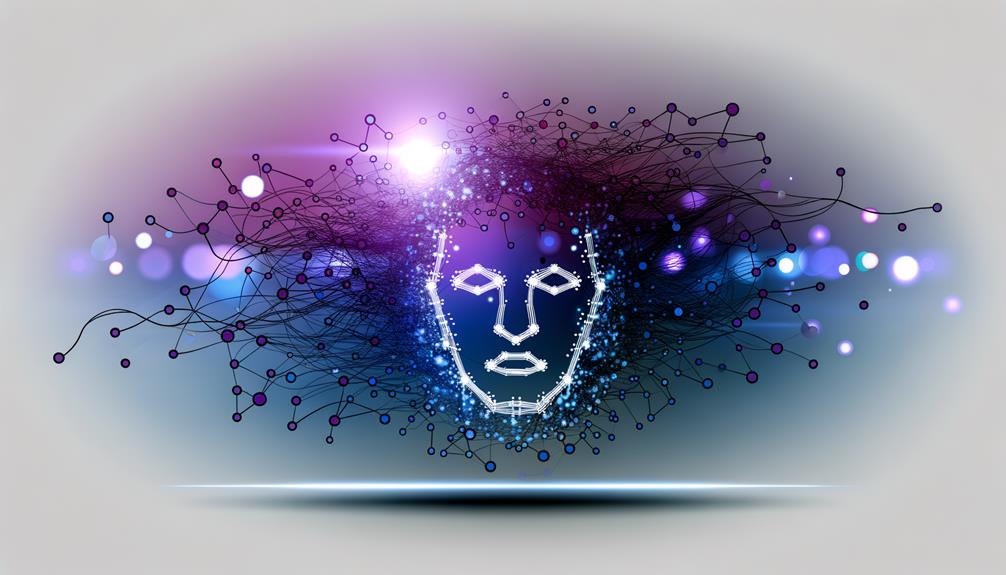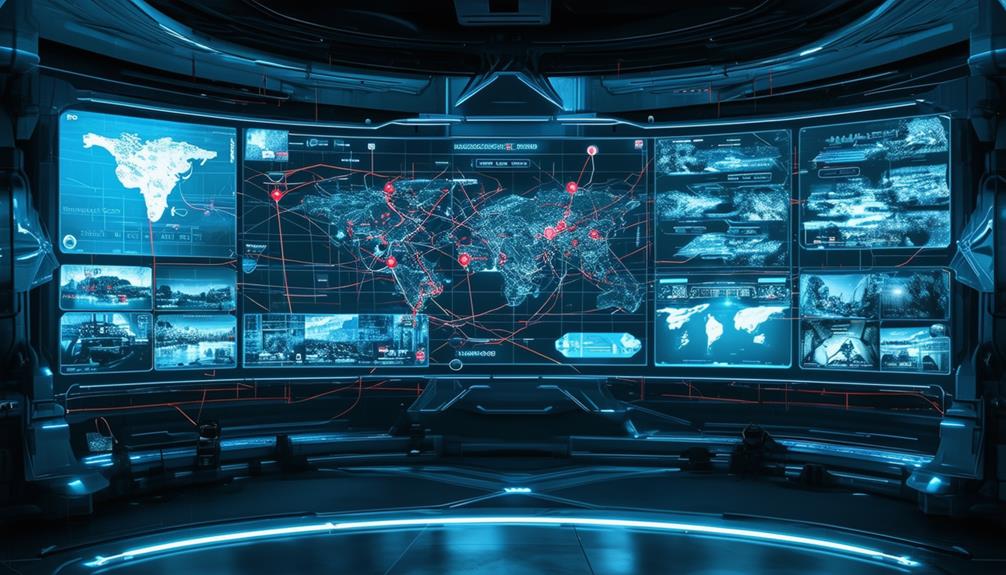To guarantee effective facial biometrics in security, follow these essential tips: Optimal Camera Placement guarantees accurate facial recognition by placing cameras at ideal positions and heights. Regular System Updates install security patches and enhance algorithms. Multi-Factor Authentication adds layers of protection. Monitoring Performance tracks error rates and algorithm efficiency. Impact of Lighting Conditions underscores the importance of proper lighting. Reducing False Positives involves tuning model parameters. Adapting to Variations adjusts algorithms for diverse environments. Learn more about these key considerations to strengthen your security integration.
Key Takeaways
- Position facial recognition cameras strategically at eye level and high-traffic areas to capture high-quality images.
- Implement multi-factor authentication methods to strengthen security and reduce unauthorized access.
- Ensure cameras are properly calibrated and updated regularly for optimal performance.
- Adjust image resolution, illumination, and remove background noise for high-quality preprocessing.
- Fine-tune model parameters and algorithms to reduce false positives and enhance recognition accuracy.
Optimal Camera Placement
To guarantee accurate facial recognition, it's vital to strategically place facial recognition cameras at ideal positions and heights, avoiding angles too high or too low to ensure the best possible capture of facial features. Installing cameras at eye level ensures that captured images are ideally aligned for facial feature extraction, resulting in higher precision.
Make sure that the area is well-lit, as sufficient lighting enhances the quality of captured faces, which are essential for efficient facial recognition.
Positioning cameras at strategic spots such as entry points, high-traffic areas, and pedestrian crossings allows for higher chances of capturing facial features accurately. These spots naturally slow down the movement of individuals, providing more time for recognition.
Camera placement should also avoid external noise like landscape objects, supports, and other obstacles that could compromise facial feature capture. Regular calibration of cameras is also necessary to maintain peak performance and accuracy over time.
Regular System Updates
As I maintain my facial biometrics system in top condition, I make sure to update it regularly to secure its performance isn't hindered by outdated software. Regular system updates are essential for maintaining the security and performance of facial biometrics technology. Updates often include security patches, bug fixes, and enhancements to the facial recognition algorithms, which ensure the best accuracy needed to prevent unauthorized access.
To remain effective in the ever-evolving cybersecurity landscape, it's important for organizations to establish a regular schedule for system updates. This proactive approach can greatly reduce the risk of security breaches and cyber attacks.
Here are the key reasons why regular system updates are crucial for facial recognition technology:
- Enhanced Security: Regular updates ensure the system is equipped with the latest security patches to counter new threats.
- Improved Performance: Updates can optimize facial recognition algorithms for higher accuracy and faster processing times.
- Bug Fixes: Regular updates fix bugs that could compromise system integrity or create vulnerabilities.
- Adaptation to New Risks: Updates allow the system to adapt to emerging threats and maintain its effectiveness.
Multi-Factor Authentication
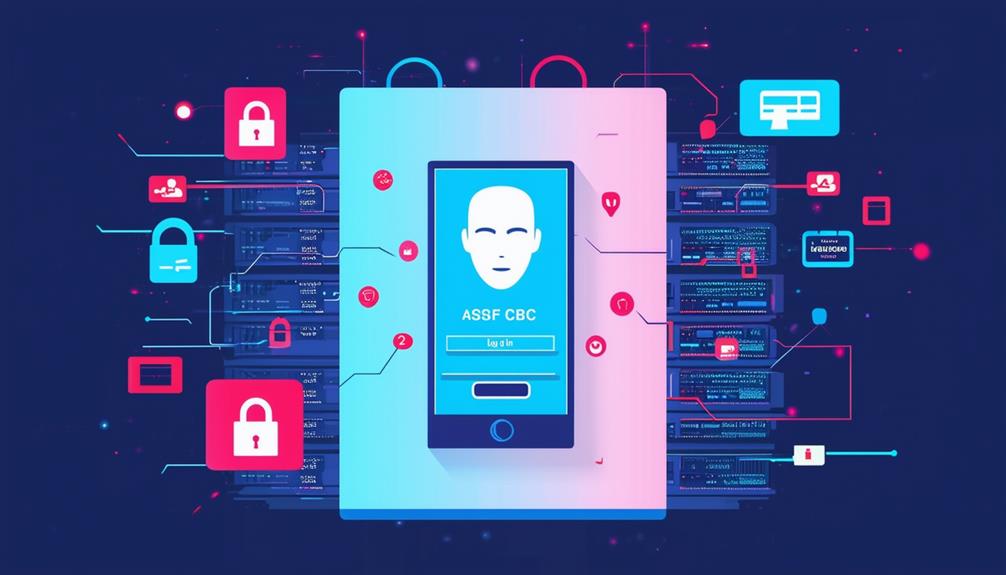
When integrating facial biometrics into a robust security plan, I firmly believe in the power of multi-factor authentication to elevate security.
This method bolsters confidence in verified identities by demanding two or more verification factors, which reduces the likelihood of successful cyber attacks.
Secure Authentication Methods
Safe Authentication Methods
By leveraging facial biometrics in conjunction with other verification methods, such as PIN codes or fingerprint scans, organizations can deploy robust multi-factor authentication to strengthen their security protocols. This integrated approach significantly enhances the protection of sensitive data and systems by adding an extra layer of defense.
Here are the key benefits of using facial biometrics in multi-factor authentication:
- Enhanced Security: Combining facial biometrics with other traits ensures that even if one method is compromised, the additional layers of authentication remain intact.
- Improved Identity Verification: Facial biometrics helps to guarantee that the user attempting to access a system is the valid owner, mitigating risks of identity theft and fraud.
- Reduced Unauthorized Access: The added security layer makes it much more challenging for unauthorized users to breach systems.
- Streamlined User Experience: Once implemented, facial biometrics can simplify login processes, reducing the need for complex passwords or additional authentication steps.
Combining Biometric Tools
I incorporate facial biometrics into a robust multi-factor authentication (MFA) by combining it with other biometric tools, ensuring that even if one method is compromised, the added layers of protection remain intact. By integrating facial biometrics with technologies like fingerprint recognition or iris scans, the system becomes more resilient against fraud and unauthorized access. This multi-layered approach enhances the overall security posture of my systems, guaranteeing a higher level of identity verification.
Using multiple biometric tools fortifies the identity verification process and reduces the risk of single-point failures. For instance, if a hacker bypasses the facial recognition system, the fingerprint or iris scan will still prevent unauthorized access. This multi-factor approach is particularly effective in high-security applications where a single …
Monitoring Performance
In the implementation and management of facial biometrics security systems, maintaining accurate performance metrics is important. I track error rates and algorithm efficiency to guarantee best real-time performance.
Monitor Error Rates
Regularly monitoring error rates in facial biometrics systems helps identify performance issues and facilitates enhancements to ensure accuracy and reliability. As I optimize system dependability, I understand the importance of monitoring error rates to detect the slightest changes that might degrade the system's performance.
Some key points to keep in mind are:
- Error rates and user satisfaction: High error rates can lead to user frustration, ultimately affecting security and reliability.
- Error rates and system efficiency: Monitoring error rates helps identify areas where the system may be inefficient, enabling targeted improvements.
- Impact of error rates on security optimization: By tracking error rates, I can maintain peak security levels and detect potential vulnerabilities.
- Regular re-evaluation: Continuous monitoring of error rates ensures that the system adapts to changing conditions and maintains its effectiveness.
Real-Time Performance Assess
To guarantee the seamless integration and best performance of facial biometrics technology in security systems, real-time monitoring of accuracy and speed is necessary. This continuous evaluation enables the immediate detection of performance issues or deviations from expected standards. By doing so, adjustments can be made promptly to optimize the system's efficiency and guarantee it works effectively for security purposes.
The real-time performance assessment involves monitoring various performance metrics such as recognition accuracy, response time, and error rates. This helps in identifying areas where improvements can be made to enhance the overall performance of the facial recognition system. By keeping a close eye on these metrics, I can make data-driven decisions to fine-tune the system and assure its reliability. For instance, if the error rate surpasses a certain threshold, I can adjust the algorithms or image processing to secure more accurate matches.
In essence, real-time performance assessment is essential for maintaining the reliability and trustworthiness of facial biometrics technology in security applications.
Algorithm Efficiency
As I explore the intricacies of facial biometrics, ensuring algorithm efficiency is crucial for deploying it effectively in security applications. I continuously assess the performance of facial biometrics algorithms to confirm they meet the strict demands of security applications, tracking metrics such as false acceptance rates (FARs) and false rejection rates (FRRs) to pinpoint efficiency issues. This thorough monitoring helps reveal potential weaknesses or anomalies that could compromise accuracy.
Continuous monitoring allows for swift modifications to the algorithm, ensuring it remains strong and efficient.
Monitoring performance metrics helps identify and resolve potential vulnerabilities in the facial biometrics system.
By maintaining optimal algorithm efficiency, facial biometrics can provide a high level of security and protection.
Regular performance assessments ensure that facial biometrics systems accurately identify individuals, upholding the highest standards of security.
Impact of Lighting Conditions

When capturing facial biometric data, proper lighting conditions are essential, as subpar lighting can greatly reduce the accuracy of facial recognition systems.
The effects of lighting on facial biometrics are profound. Shadows, glares, and uneven lighting can distort facial features, significantly impacting the biometric analysis.
Consistent and appropriate lighting ensures a clear image capture that allows for more precise facial recognition results.
Advanced biometric systems are designed to adjust to different lighting conditions in order to maintain reliable performance. This is particularly important for security measures, where facial recognition is used to verify identities.
(eldrean et al., 2023).
Preprocessing Image Quality
I adjust the brightness and contrast of the captured facial images to enhance the quality, which directly impacts the precision of facial recognition. This pivotal step is often overlooked despite its significant influence on the accuracy of biometric analysis.
Preprocessing techniques play an essential role in optimizing facial images for efficient analysis, leading to more precise and reliable identification results.
When it comes to preprocessing image quality, I focus on the following key aspects to guarantee high performance in facial biometrics:
- Adjusting Image Resolution: Ensuring a suitable resolution for the images facilitates accurate feature extraction and comparison.
- Removing Background Noise: Eliminating unnecessary data improves the quality of facial features used for recognition.
- Correcting Illumination: Optimizing lighting conditions helps k
Reducing False Positives
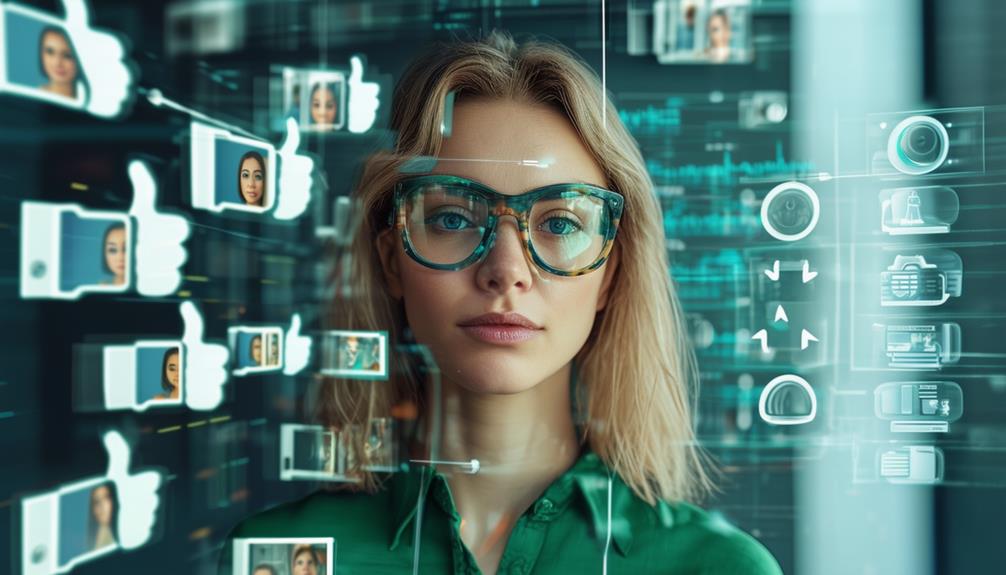
To reduce false positive identifications in facial biometrics, I focus on fine-tuning model parameters and ensuring high-quality biometric data.
Implementing advanced algorithms and regularly refining the system through performance data helps minimize inaccurate matches.
Additionally, incorporating multi-factor authentication and user training on best facial positioning can further enhance security.
Algorithm Tuning
Facial biometric algorithms require precise tuning to minimize false positives and guarantee robust security. This involves adjusting sensitivity thresholds and feature matching criteria to achieve peak accuracy. As I explore the intricacies of algorithm tuning, I realize the significance of fine-tuning these parameters to make sure that security systems are reliable and efficient.
To optimize facial biometrics algorithms, here are key considerations:
- Feature matching criteria: Adjusting the criteria to ensure that the algorithms accurately match facial features can greatly reduce false positives.
- Sensitivity thresholds: Fine-tuning these thresholds allows the algorithm to avoid misidentification and maintain a high level of accuracy.
- Image quality thresholds: Ensuring that the algorithm can handle varying image qualities is essential to avoid false negatives.
- Data quality: The quality of the training data is directly proportional to the algorithm's performance, making high-quality data essential for accurate facial recognition.
Biometric Data Quality
When integrating facial biometrics into security systems, the quality of biometric data is vital in reducing instances of false positives and guaranteeing accurate identifications.
High-quality biometric data minimizes instances of false positives in facial recognition systems by mitigating the impact of environmental factors such as lighting, camera angle, and image resolution. These factors significantly influence the reliability of data, and hence, it's essential to optimize these conditions to obtain high-quality images.
Advanced algorithms have the capability to compensate for minor variations in image quality, but they can't fully overcome poor data quality. As a result, regularly calibrating and maintaining facial recognition systems becomes necessary to ensure consistent data quality.
High-quality biometric data results in fewer false positives, which in turn enhances the overall trustworthiness of facial recognition systems. Facial biometrics, when implemented with high-quality data and advanced algorithms, offer a robust and reliable means of authentication, leading to improved security without sacrificing personal freedom.
Adapting to Variations
As I explore the complexities of facial biometrics in security, addressing the challenges posed by lighting and environmental factors is important. Shadows and reflections can have a notable impact on the accuracy of facial recognition technology, making it essential to develop advanced solutions to adapt to these variations.
To ensure dependable identification, facial biometrics systems must be able to handle various lighting conditions, angles, and facial expressions. Here are some key considerations:
- Adaptive algorithms: Implementing algorithms that can adjust to different lighting conditions and environmental factors helps mitigate the influence of variations.
- Advanced preprocessing techniques: Enhancing image quality through preprocessing can greatly enhance the performance of facial biometrics systems.
- Continuous monitoring and updates: Regularly updating and monitoring the facial biometrics system is crucial to maintaining accuracy in diverse conditions.
- Diverse dataset training: Training facial recognition systems on a diverse dataset of faces improves recognition performance across different demographics and situations.
Resolving Technical Issues
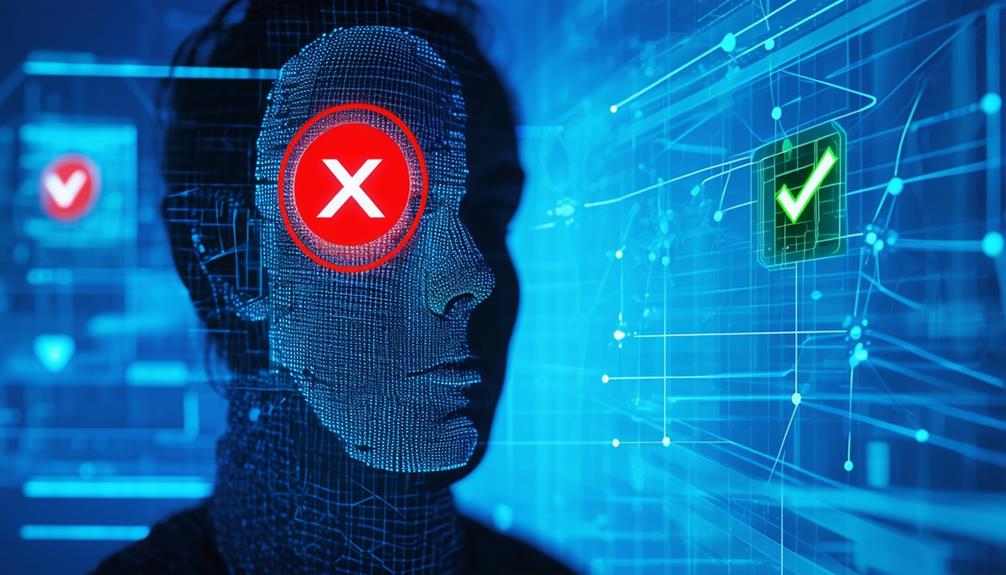
To maintain the reliability and efficiency of facial biometrics systems, incorporating robust maintenance and troubleshooting protocols is important to prevent technical issues that can disrupt security operations and compromise overall system effectiveness.
Regular updates and checks are necessary for facial recognition systems to guarantee they remain accurate and reliable. Ignoring these updates can lead to technical issues that compromise the system's performance.
By keeping track of system performance metrics, we can proactively identify and tackle technical issues before they escalate into system failures.
Implementing redundancy measures and backups is essential to mitigate risks of system failures. If a system failure does occur, swift collaboration with technical support teams and vendors is crucial for timely resolution. This collaboration ensures that the issue is addressed efficiently, reducing the potential for more substantial disruption to security operations.
Maintaining User Trust
Maintaining User Trust
Ensuring transparency in data collection and usage forms the cornerstone of building user trust in facial biometrics security measures, as it directly addresses concerns of privacy and personal security. Trust flourishes when users understand the vast but precise data collected, how it's stored, and the consumption pattern of sensitive facial features. This clear understanding empowers users with the confidence that their biometric identities are appreciated, handled responsibly, and respected.
- Obtain Consistent Consent: Prior affirmative consent from individuals must be a steadfast principle in facial biometrics systems, fostering trust that their participation is voluntary and identifiable.
- Provide Data Security: Safeguarding facial biometrics data through robust security measures maters in instilling and maintaining user trust.
- Update Users: Continuing updates on any changes or enhancements are essential in sustaining user faith and demonstrating devotion to transparency.
- Maintain Data Transparency: Ensuring transparency in how facial data is stored and protected bolsters user confidence in the system, solidifying trust homeland.
Frequently Asked Questions
How Can We Make Biometrics More Secure?
To make biometrics more secure, I employ encryption methods, multi-factor authentication, and liveness detection to prevent spoofing, ensuring accurate verification and protecting data from unauthorized access.
How Do You Beat Facial Recognition?
To beat facial recognition, I use methods that manipulate facial features and lighting conditions. Techniques include facial spoofing attacks, anti-spoofing measures, mask detection, and leveraging deep learning to enhance facial recognition accuracy.
How Is Facial Recognition Used in Security?
"In security, I employ facial recognition for authentication, surveillance, and identity verification to prevent fraud and improve access control. Despite privacy concerns, it enhances overall safety through accurate facial feature analysis."
What Is the TSA Biometrics Strategy?
"My TSA biometrics strategy leverages facial recognition technology to enhance security, efficiency, and passenger experience, ensuring voluntary participation, privacy protection, and data safety, while continually monitoring technology advancements and applications."

